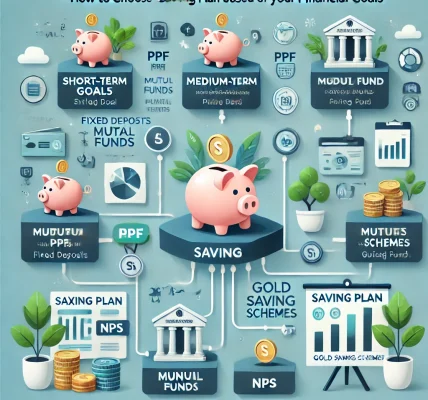In today’s world, creating passive income streams is one of the most effective ways to build long-term financial security. Passive income allows you to earn money with minimal ongoing effort, freeing up time for other pursuits while still generating income. One of the most effective tools for creating passive income is through well-planned saving strategies, such as retirement accounts, dividend-paying investments, and high-yield savings accounts.
In this blog, we’ll explore how you can leverage different saving plans to build a passive income stream, ensuring your financial future remains secure and prosperous. By following these steps and using the right financial tools, you can turn your savings into an income-generating asset.
What is Passive Income?
Before we dive into saving plans, it’s important to understand what passive income is and how it differs from active income.
- Active income is money you earn through direct efforts, such as working a job or freelancing.
- Passive income, on the other hand, is income that requires minimal ongoing effort after the initial setup. This could include rental income, dividends from investments, or earnings from a business you no longer actively manage.
In short, creating passive income through your saving plans means using your money to make more money, allowing your wealth to grow even when you’re not working.
How Saving Plans Can Help You Create Passive Income
Saving plans are not only useful for covering immediate expenses or building emergency funds—they can also serve as powerful tools for creating passive income streams. Here are some strategies you can use:
1. High-Yield Savings Accounts
A high-yield savings account is one of the simplest ways to start earning passive income. These accounts offer interest rates higher than traditional savings accounts, allowing your savings to grow faster. While the interest earned might not make you rich, it’s a great starting point for building passive income with minimal risk.
- How It Works: You deposit money into a high-yield savings account, and the bank pays you interest on the balance. The higher the interest rate, the more money you can earn passively over time.
- Why It’s Great for Passive Income: It’s low-risk, easy to manage, and your funds are typically liquid, meaning you can access your money when needed.
Tip for Maximizing Passive Income:
Look for online banks or credit unions offering higher interest rates than traditional banks. Even a small difference in the rate can significantly impact your long-term earnings.
2. Dividend-Paying Stocks
Investing in dividend-paying stocks is another excellent way to create passive income. When you invest in dividend stocks, you receive periodic payments (usually quarterly) based on the company’s profits. These payments can be reinvested to grow your portfolio or used as a source of income.
- How It Works: You purchase shares in companies that pay dividends. As the company earns profits, a portion of those profits is distributed to shareholders.
- Why It’s Great for Passive Income: If you invest in a diversified portfolio of high-quality dividend stocks, you can create a steady stream of passive income. Some investors even use dividends as a reliable income source in retirement.
Tip for Maximizing Passive Income:
Focus on Dividend Aristocrats—companies that have a long history of increasing dividends annually. These stocks tend to be more reliable and offer a higher chance of consistent payouts.
3. Real Estate Investments
Real estate has long been a powerful way to generate passive income, primarily through rental properties. While buying property requires an initial capital investment, it can provide consistent monthly cash flow once the property is rented out.
- How It Works: You purchase a property and rent it out to tenants. The rental income generated from the property is your passive income. Additionally, the property may appreciate in value over time, leading to capital gains when you sell.
- Why It’s Great for Passive Income: Real estate can offer regular cash flow through rent, tax advantages, and the potential for property value appreciation.
Tip for Maximizing Passive Income:
Consider investing in Real Estate Investment Trusts (REITs) if you prefer not to deal with the hassle of property management. REITs are companies that own or finance income-producing real estate and distribute a significant portion of the profits to shareholders in the form of dividends.
4. Retirement Accounts (401(k), IRA)
While retirement accounts like a 401(k) or Individual Retirement Account (IRA) may seem like long-term saving tools, they can also be used to generate passive income once you reach retirement. Both of these accounts allow you to invest in a range of assets, such as stocks, bonds, and mutual funds, which can provide passive income through dividends, interest, or capital gains.
- How It Works: You contribute money to your retirement account, and the funds grow tax-deferred (or tax-free, in the case of a Roth IRA). As your investments generate returns, you can withdraw them during retirement, providing a steady income stream.
- Why It’s Great for Passive Income: Retirement accounts allow you to invest for the long-term, creating a stable source of passive income in retirement.
Tip for Maximizing Passive Income:
Max out your contributions to retirement accounts and invest in a diversified portfolio of dividend-paying stocks, bonds, and index funds to generate long-term passive income.
5. Peer-to-Peer Lending
Peer-to-peer (P2P) lending is a growing way to earn passive income. Through P2P lending platforms, you can lend money to individuals or small businesses in exchange for interest payments. These platforms act as intermediaries, allowing you to invest your money and earn interest as borrowers repay their loans.
- How It Works: You invest in loans on a P2P lending platform, which then earns interest as the borrower repays the loan.
- Why It’s Great for Passive Income: P2P lending offers potentially higher returns than traditional savings accounts, but with a higher level of risk. It can be a good option for diversifying your income sources.
Tip for Maximizing Passive Income:
Carefully evaluate the risk level of each loan and consider diversifying your investments across multiple borrowers to reduce the potential for loss.
Building a Balanced Passive Income Portfolio
To maximize your passive income, it’s essential to build a balanced portfolio that includes a combination of low-risk and higher-risk strategies. Here’s how to create a well-rounded passive income stream:
- Diversify Your Investments: Don’t put all your eggs in one basket. A balanced portfolio that includes dividend stocks, real estate investments, and savings accounts can provide a stable income stream with less risk.
- Reinvest Earnings: Whether it’s dividends from stocks or interest from savings accounts, reinvest your earnings to compound your returns over time.
- Stay Consistent: Consistent contributions and long-term investments will gradually build a passive income stream that provides financial freedom in the future.
Conclusion: Using Saving Plans to Create Passive Income
Creating a passive income stream through saving plans is a smart and effective way to build wealth and achieve financial freedom. Whether you’re leveraging high-yield savings accounts, investing in dividend stocks, or exploring real estate and peer-to-peer lending, these strategies can help you generate income with minimal ongoing effort.



